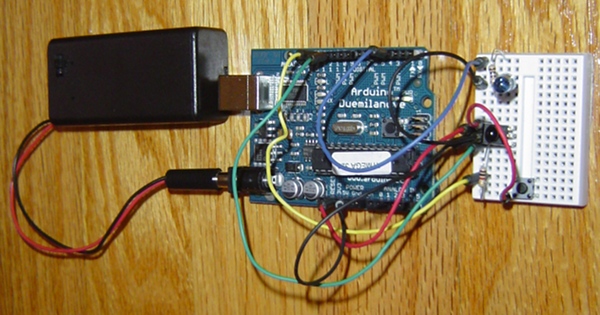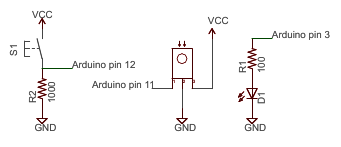To use the universal remote, simply point your remote control at the IR module and press a button on the remote control. Then press the Arduino button whenever you want to retransmit the code. My example only supports a single code at a time, but can be easily extended to support multiple codes.
The hardware

The above picture shows the 9V battery pack, the Arduino board, and the proto board with (top-to-bottom) the IR LED, IR receiver, and pushbutton.
The circuitry is simple: an IR sensor module is connected to pin 11 to record the code, an IR LED is connected to pin 3 to transmit the code, and a control button is connected to pin 12. (My IR library article has details on the sensor and LED if you need them.)

The software
The code can be downloaded as part of my IRremote library download; it is the IRrecord example.
Handling different protocols
The code supports multiple IR protocols, each with its own slight complications:Sony codes can be recorded and played back directly. The button must be held down long enough to transmit a couple times, as Sony devices typically require more than one transmission.
The common NEC protocol is complicated by its "repeat code". If you hold down a button, the remote transmits the code once followed by multiple transmissions of special repeat code. The universal remote records the code, not the repeat code. On playback, it transmits the code once, followed by the repeat code.
The RC5 and RC6 protocols handle repeated transmissions differently. They use two separate codes for each function, differing in a "toggle bit". The first time you hold down a button, the first code is transmitted repeatedly. The next time you hold down a button, the second code is transmitted repeatedly. Subsequent presses continue to alternate. The universal remote code flips the toggle bit each time it transmits.
The universal remote handles any other unknown protocol as a "raw" sequence of modulated IR on and off. The main complication is that IR sensor modules typically stretch out the length of the "on time" by ~100us, and shorten the "off time" correspondingly. The code compensates for this.
Most likely there are some codes that that can't handle, but it has worked with the remotes I've tried.
The code also prints debugging information to the serial console, which can be helpful for debugging any problems.
In conclusion, this is intended as a proof of concept rather than a useful product. The main limitation is supporting one code at a time, but it's straightforward to extend the code. Also note that the record and playback functions can be separated; if you know the IR codes you're dealing with, you can use just the necessary function.